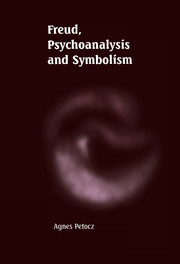Book contents
- Frontmatter
- Contents
- List of figures
- Preface
- Introduction
- Part One Exegesis and Extraction
- 1 From disorder towards the focus of inquiry
- 2 The ‘Freudian Narrow’ (FN) theory of symbolism
- 3 The ‘symbol’ in Freud's early writings (1893–1899)
- 4 Continuation and elaboration (1900–1913)
- 5 The ‘core years’ for the FN theory (1914–1917)
- 6 The treatment of symbolism in Freud's later writings (1918–1940)
- Part Two Consolidation and Defence
- Epilogue
- List of references
- Index
2 - The ‘Freudian Narrow’ (FN) theory of symbolism
Published online by Cambridge University Press: 22 October 2009
- Frontmatter
- Contents
- List of figures
- Preface
- Introduction
- Part One Exegesis and Extraction
- 1 From disorder towards the focus of inquiry
- 2 The ‘Freudian Narrow’ (FN) theory of symbolism
- 3 The ‘symbol’ in Freud's early writings (1893–1899)
- 4 Continuation and elaboration (1900–1913)
- 5 The ‘core years’ for the FN theory (1914–1917)
- 6 The treatment of symbolism in Freud's later writings (1918–1940)
- Part Two Consolidation and Defence
- Epilogue
- List of references
- Index
Summary
In Freudian scholarship it is notoriously difficult to give a substantial account of any important topic, other than perhaps the most general underlying theses, which may confidently be claimed to be a faithful representation of Freud's own views. Freud himself is largely responsible for this. The revolutionary nature of his theory, and the fact that it evolved over a long period, meant inevitable changes in his ideas. Freud complained of the ‘no-win’ situation in which he was left by his critics as a result of these changes: ‘Some people have taken no notice whatever of my self-corrections and continue to this day to criticize me for hypotheses which have long ceased to have the same meaning for me. Others reproach me precisely for these changes and regard me as untrustworthy on their account’ (1916/17, pp. 245–6). In addition, while Freud considered himself a scientist, always insisting that his work was an empirical search for truth, and thus part of the scientific Weltanschauung, his language is frequently imbued with more literary qualities, often displaying, as Cheshire and Thomä (1991) observe, an artist's tolerance for looseness and ambiguity. Of course, this is partly because he lacked an accepted ‘technical’ terminology in which to express his new ideas, and partly because the typically austere, precise, ‘scientific’ prose style was not yet commonplace.
- Type
- Chapter
- Information
- Freud, Psychoanalysis and Symbolism , pp. 21 - 35Publisher: Cambridge University PressPrint publication year: 1999



